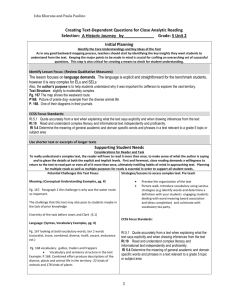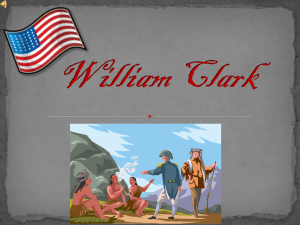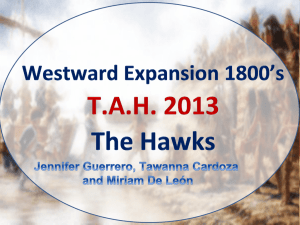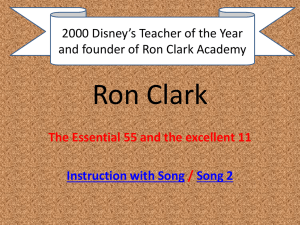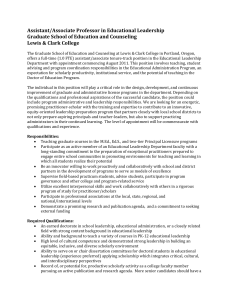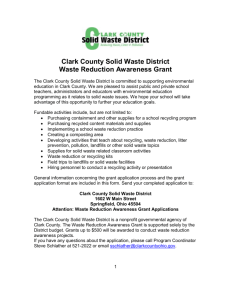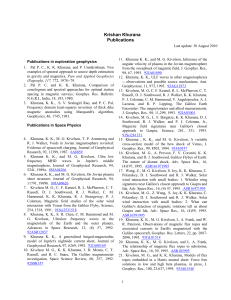A Historic Journey Lesson 2
advertisement
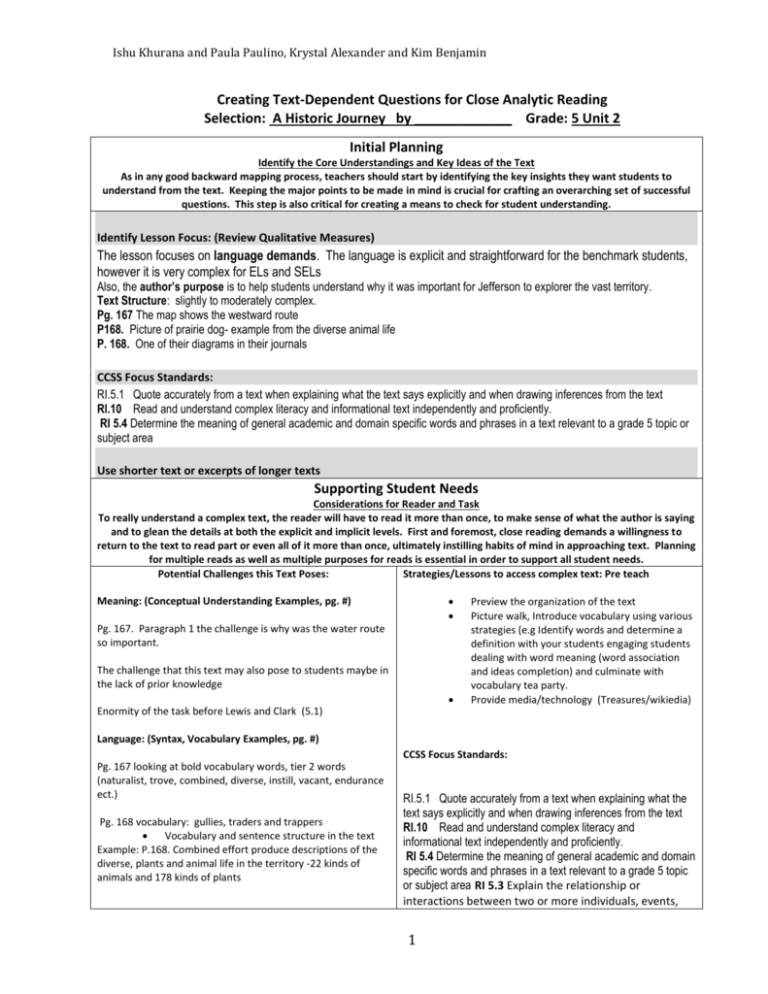
Ishu Khurana and Paula Paulino, Krystal Alexander and Kim Benjamin Creating Text-Dependent Questions for Close Analytic Reading Selection: A Historic Journey by _____________ Grade: 5 Unit 2 Initial Planning Identify the Core Understandings and Key Ideas of the Text As in any good backward mapping process, teachers should start by identifying the key insights they want students to understand from the text. Keeping the major points to be made in mind is crucial for crafting an overarching set of successful questions. This step is also critical for creating a means to check for student understanding. Identify Lesson Focus: (Review Qualitative Measures) The lesson focuses on language demands. The language is explicit and straightforward for the benchmark students, however it is very complex for ELs and SELs Also, the author’s purpose is to help students understand why it was important for Jefferson to explorer the vast territory. Text Structure: slightly to moderately complex. Pg. 167 The map shows the westward route P168. Picture of prairie dog- example from the diverse animal life P. 168. One of their diagrams in their journals CCSS Focus Standards: RI.5.1 Quote accurately from a text when explaining what the text says explicitly and when drawing inferences from the text Rl.10 Read and understand complex literacy and informational text independently and proficiently. RI 5.4 Determine the meaning of general academic and domain specific words and phrases in a text relevant to a grade 5 topic or subject area Use shorter text or excerpts of longer texts Supporting Student Needs Considerations for Reader and Task To really understand a complex text, the reader will have to read it more than once, to make sense of what the author is saying and to glean the details at both the explicit and implicit levels. First and foremost, close reading demands a willingness to return to the text to read part or even all of it more than once, ultimately instilling habits of mind in approaching text. Planning for multiple reads as well as multiple purposes for reads is essential in order to support all student needs. Potential Challenges this Text Poses: Strategies/Lessons to access complex text: Pre teach Meaning: (Conceptual Understanding Examples, pg. #) Pg. 167. Paragraph 1 the challenge is why was the water route so important. The challenge that this text may also pose to students maybe in the lack of prior knowledge Preview the organization of the text Picture walk, Introduce vocabulary using various strategies (e.g Identify words and determine a definition with your students engaging students dealing with word meaning (word association and ideas completion) and culminate with vocabulary tea party. Provide media/technology (Treasures/wikiedia) Enormity of the task before Lewis and Clark (5.1) Language: (Syntax, Vocabulary Examples, pg. #) CCSS Focus Standards: Pg. 167 looking at bold vocabulary words, tier 2 words (naturalist, trove, combined, diverse, instill, vacant, endurance ect.) Pg. 168 vocabulary: gullies, traders and trappers Vocabulary and sentence structure in the text Example: P.168. Combined effort produce descriptions of the diverse, plants and animal life in the territory -22 kinds of animals and 178 kinds of plants RI.5.1 Quote accurately from a text when explaining what the text says explicitly and when drawing inferences from the text Rl.10 Read and understand complex literacy and informational text independently and proficiently. RI 5.4 Determine the meaning of general academic and domain specific words and phrases in a text relevant to a grade 5 topic or subject area RI 5.3 Explain the relationship or interactions between two or more individuals, events, 1 Ishu Khurana and Paula Paulino, Krystal Alexander and Kim Benjamin ideas, or concepts in a historical, scientific, or technical text based on specific information in the text. Pre teach 1. 2. 3. Activity/Lesson Pre teach listed vocabulary Picture Walk Access informational text 1.Define, example, ask and visual glossary Idea completion; Lewis and Clark were naturalist because__________ Word association; diverse (ask students to think of similar words that will mean diverse) people, plants and animals are different. (Which words represent diversity) 2. Think pair share (square), have students generate questions for their peers from the text, identify how the author has organized this selection (e.g heading, sub headings, captions and maps) First Read: Teacher will read the entire selection for the general idea and the gist. The selection is only 3-pages long. The strategies will be summarizing. Teacher models the first paragraph. Close Reads Create Coherent Sequence of Text-Dependent Questions Create Coherent Sequences of Text-Dependent Questions – Start Small to Build Confidence The opening questions should help orient students to the text, and be specific enough to answer so students gain confidence. The sequence of questions should not be random but should build toward more coherent understanding and analysis to ensure that students learn to stay focused on the text to bring them to a gradual understanding of its meaning. Think of ways to maximize student engagement. Close Read I (Start small to build confidence) Learning Focus: Author’s Purpose Focus CCSS: RI.5.1 Quote accurately from a text when explaining what the text says explicitly and when drawing inferences from the text Rl.10 Read and understand complex literacy and informational text independently and proficiently. Text-Dependent Questions Evidence-Based Answers/Pg. # Pg. 167 2 Ishu Khurana and Paula Paulino, Krystal Alexander and Kim Benjamin Why did President Jefferson ask Lewis and Clark He wanted to find a water route between to explore a huge area of North America? (167) Mississippi river and the Pacific Ocean to boost Note: Talk to your partner to make sure that the trade you can both show evidence from text Pg. 167 What did Jefferson expect them to report on? He expected them to report on people, plants (167) and animals that inhabited the territory. Pg. 168 Pg. 168 (inferential question) Why did Lewis and Clark capture a live “prairie They wanted Jefferson to see an example of dog” and send it to President Jefferson in the new animals they had discovered in that Washington? territory. Students may make different inferences as to why a live animal was sent. What do you think was the reason for the Pg. 168 buffalos to move south? (168) By fall the buffalos were starting to move south because the weather was going to be harsh up north. Pg. 167 Why does the author say, “ A few months later, The buffalos were moving south to the feast of fresh buffalo were just pleasant wintering grounds and they couldn’t be hunted memories.” (167) for fresh meat, that the explorers had enjoyed earlier and that is why they were just pleasant memories. What did the team members eat while the Pg. 168 buffalos were gone south? (168) Native Americans were great hosts and they introduced them to the mule deer meat since buffalo meat was unavailable. Why did the author called Clark a horrible P. 169 speller? (169) When they finally reached the Pacific Ocean, Clark wrote in his journal “ocian” instead of ocean. More examples of misspell words are found in A Historic Journey in Wonders. Close Read II. Learning Focus: Cause and Effect Focus CCSS: RI 5.3 Explain the relationship or interactions between two or more individuals, events, ideas, or concepts in a historical, scientific, or technical text based on specific information in the text. RI.5.1 Quote accurately from a text when explaining what the text says explicitly and when drawing inferences from the text Rl.10 Read and understand complex literacy and informational text independently and proficiently. Text-Dependent Questions What is meant by the term “naturalist” (167) Evidence-Based Answers/Pg. # Pg. 167 3 Ishu Khurana and Paula Paulino, Krystal Alexander and Kim Benjamin Looking at the map on Pg. 167, What alternatives routes could Lewis and Clark could have considered? How would today’s technology change the Lewis and Clark expedition? What does the author mean when he says, “keeping track while making tracks?” (169) Why did the author title the selection A Historic Journey? What is the author’s perspective about Lewis and Clark? P. 169 Because they both kept excellent maps and diaries of everything they saw in nature and learned. Their combined efforts were used………(167) Understand pro and cons of different routes Pg. 167. Alternate routes may or may not have been feasible. Pg. 169 There is a pun on the word track. While they were exploring (making tracks), the great endless plains, jagged rocky mountains, and the glittering Pacific Ocean, they were also keeping track (writing in their journals) of what they saw and when they saw. Inferential question By inference the students can say that the author called this selection A Historic Journey because no explorer before had kept extensive journals, maps and diagrams. This was perhaps the first time and therefore historic. Pg. 169 Students can infer that the author has great respect and admiration for these explorers. He is impressed by their courage to take on the assignment, their endurance and their keen observational skills to notice the enormous diversity in plants and animals. The author uses the word courage, endurance and keen observation in describing them. Checking for Understanding How will you know that learning has occurred? Planning for a means to check student understanding is crucial. Refer back to the Lesson Focus to plan intentionally to check for student understanding. Describe how you will check for student understanding: The teacher will check for understanding by listening to the students during peer-to-peer collaboration and listening for academic vocabulary. The students will provide evidence from the selection for their oral responses. Using a flow map and inviting responses from the students about cause and effect the teacher will gauge students understanding of the selection and clear misconceptions. The culminating activity will be for students to create an interview between Jefferson and Lewis and Clark. The setting for the interview will be before the expedition takes place and at 4 Ishu Khurana and Paula Paulino, Krystal Alexander and Kim Benjamin the conclusion of the expedition. Conduct the interview from two perspectives: 1) Historical and 2) Present time Continuing to read about the historic journey in Wonders can also extend this learning. Louisiana Purchase Pg. 174-175 A Historic Journey 176-177 STUDENTS FIGURE OUT THE MEANING sufficient context clues are provided in the text TEACHER PROVIDES DEFINITION not enough contextual clues provided in the text Vocabulary KEY WORDS ESSENTIAL TO UNDERSTANDING Words addressed with a question or task WORDS WORTH KNOWING General teaching suggestions are provided in the Introduction diverse, geography, trapper, gullies, vacant (Considerations for ELs) Expedition, water route, Naturalist, territory, trove 5
